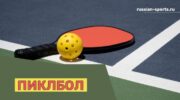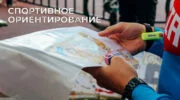In the article “Curling” we will tell you about the winter sport of curling with stones. You will learn the history of curling, the rules and technological features of the sport.
#Curling #ProCurling #WinterSports #Sports #Ice
If asked what sport uses mops, many would think that they are played and only some would say that the sport is “Curling. Not mops, but special brushes are an integral part of curling, like clubs in hockey or racquets in tennis.
Curling is a game in which participants launch heavy projectiles of polished granite on the ice. The sport was invented in medieval Scotland. From Scotland, with the help of traders it came to the Netherlands, and 200 years later, along with settlers migrated to America. Soon after, it spread around the world.

The rules of curling were officially established in the 19th century. The two main countries where curling was most popular, Scotland and Canada, created an international competition called the Scotch Cup, which was first held in 1959.
Literally within ten years the sport had gained popularity in Europe. Six more countries joined the international competition: USA, Sweden, Norway, Switzerland, France and Germany. The World Curling Federation was founded in 1967.
For a long time curling had the status of a demonstration sport at the Olympic Games. It made its debut as a full participant only in 1998 at the Winter Games in Nagano. In 2016, in honor of the anniversary of the world organization, significant changes were made to the rules. Since 2018, the sport has hosted the World Cup.
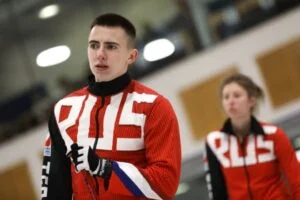
The history of curling in Russia is quite curious, because it came to our country twice. The first time it was in the 19th century, in 1873 English and German diplomats opened the first curling club in Moscow. Three years later two more clubs opened, but already in St. Petersburg. World War I and then the revolution led to the closure of the clubs.
The second birth of Russian curling was in 1991 in St. Petersburg. And in 1992 Russian curlers were accepted into the International Federation. Interestingly, it was the juniors who brought the first international award to Russian curling – in 1995 they won bronze at the European Championship.
The real success for our athletes is yet to come, because curling is not as popular in Russia as it is in Canada, the undisputed leader in the sport. In time, clubs and sections of this exciting game will appear in all cities.

The rules of this game are not complicated at all, but it takes skill and experience to achieve results. The game takes place on a special ice field 45 meters long, at one end of which a circular target with a diameter of just over 3.5 meters is drawn on the ice. This target is called “home”.
Players launch towards the house round granite projectiles – stones, weighing 20 kilograms. The best stones are considered to be Scottish and Canadian-made. The game involves two teams of 4 people. Captain in curling is called “Skip”, he has a deputy – “Vice-skip”.
A curling match consists of 10 rounds (endings). During one end, players on each team take turns launching eight stones. There is an art to launching a stone. A player gets down on one knee and grips the handle of the stone, then gently pushes off the block with one foot, sliding on one knee, aiming and directing the stone. Before launching, the player may twist the stone slightly with the movement of the hand.
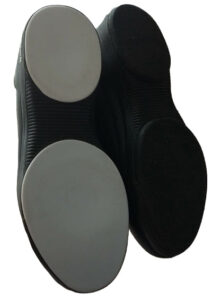
Interestingly, the curlers’ shoes have different soles. The outsole on the kicking shoe is rough to provide a powerful kick. The sole of the second shoe is smooth, because it should not interfere with sliding.
After the stone is launched, its speed and direction can be influenced by rubbing the ice in front of it with special brushes. These brushes are made of either natural bristles or nylon.
Rubbing the ice in front of the stone is called “sweeping.” The skip uses the tip of the brush to show the other participants where to point the stone. When the stone is launched by the skip himself, the vice-skip takes over.
At the end of the end, the more accurate team gets a point for each stone in the house that is closer to the center than the opponent’s stone, so only one team gets points. The team that scores the most points in 10 endings wins the game.
At first glance, curling looks like a very simple game, but in fact it is not. Curling requires excellent judgement, steady hand and strategic thinking.

The ability to change the trajectory of the stone on the move allows the skip to strategize the game. By specifying how and where to send the stone, an experienced skip can calculate several moves in advance the possible reaction of the opponent and destroy his plans. But in order to do this, the stones must fall exactly into the places planned by the skip.
Curling requires perfect team chemistry, because often literally just a few inches of trajectory play a decisive role. Therefore, the ability to quickly orientate on the court and give accurate instructions to the other players is no less valuable to the team captain than the ability to correctly place the stones on the court and calculate the possible actions of the opponent.
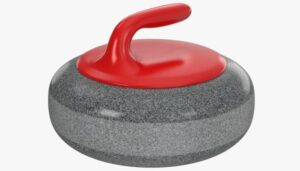
It is important for the other players to be able to follow their captain’s commands precisely. Rubbing the ice in front of a moving stone is not easy at all, because the players have only seconds at their disposal. Beginning curlers lose up to 2 kilograms of weight per match.
Curling is a wonderful combination of athletic action and analytical thinking, it is not by chance that curling fans call it “chess on ice”.
Many people wonder, “How does rubbing the ice in front of a stone help change its trajectory?” First of all, you have to pay attention to the unusual way of preparing ice for curling.
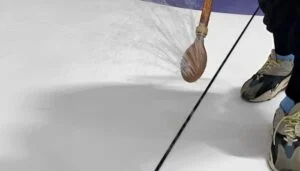
The ice surface is first filled with water, and then the freezing machines underneath it are turned on. Then special machines (combines) grind the ice just as it is done in hockey and figure skating. After grinding, the surface of the ice is sprayed with small drops of water using special equipment.
That is why curling ice is layered. This is done in order for the stones to slide better. Otherwise, the polished, flat bottom of the stone will become firmly pressed against the polished ice. This effect of “ice sticking to the polished surface” can very often be observed when trying to remove frozen ice plates from the glass; they slide back and forth on the glass, but do not want to separate in any way. This effect is very familiar to all motorists.

The same thing would happen with a curling stone. The bottom of the stone is loose on the ice due to the bumps, and the stone slides freely on its surface. When the players rub the ice, the resulting friction causes the temperature of the bumps to rise, they begin to melt, and they become covered with tiny drops of water.
The water begins to act as a lubricant between the stone and the ice, and if you rub the ice exactly in front of the stone, it will move longer. If you rub the area slightly away from the path of the stone, the stone will start to move, because there will be less friction on the rubbing side.
Everything in the world is built on the same principles, which, in turn, are based on universal physical laws. To play curling you don’t need to learn physical equations, just practice regularly and be able to work as a team.
Unfortunately, curling is not widespread in our country and there are curling clubs only in big cities, but curling has no age restrictions. This sport is gaining popularity every year, and maybe in a year you will become the skip who will bring our country many new and bright victories in European and world championships.
About curling
FAQs
What is curling?
Curling is a team winter sport in which participants launch heavy projectiles of polished granite into a painted target, just over 3.5 meters in diameter, on a special ice area.
What are the strongest teams in curling?
- Men's teams: Sweden, Switzerland and Canada;
- Women's teams: Switzerland, Sweden and the Republic of Korea;
- Mixed doubles (double-mixed): Canada, Switzerland, Norway;
- Mixed doubles (mix): Canada, Scotland, Norway;
- Wheelchair curling: China, Norway, Russia.
Russia's most famous curling players?
- Anastasia Bryzgalova;
- Alexander Krushelnitsky;
- Ludmila Privivkova;
- Anna Sidorova;
- Artur Ali.
How much does a stone weigh in curling?
The curling stone weighs 19 kg and 960 grams (44 pounds). The stone is made in Canada from special granite, which is mined in Wales and Scotland.






